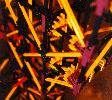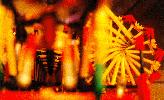
Are you having problems keeping the ball on the tubing ramp of the K'NEX Big Ball Factory? With a few modifications, you can change this route for the ball (one of four different ones in the BBF) to something much more reliable.
When the initial assembly of the BBF was complete and powered with an electric motor, we had some difficulty keeping balls on the curving "roller-coaster" track containing tubing. This seemed to be due mostly to the tilt or twist of the circular green-and-white part that is necessary in order to move the ball path one square forward (from the outside-connected ramp over to the slightly-sloping ramp above the main BBF cross member). We tried twisting the C-shaped section in various ways (there wasn't much play in it, actually), but without success. Much of the time, the ball would fly off the ramp at a point near the bottom of the straight part of the ramp. There may also have been a detrimental effect caused by the tubing itself - from either usage or temperature changes, it seemed to distort its shape a bit over time.
Because of these problems, we worked toward finding a more reliable arrangement for this ball path. We borrowed the idea that is used in the original design to channel balls vertically through the left-hand tower, with interior rods used to keep the ball inside a single column of cubes. In the modified design, the right-hand tower is used to channel balls internally and diagonal yellow rods provide sloping ball exit paths. The design modification involves removing the original short ramp leading to the tubing track, as well as the entire tubing track itself. Instead, various new cantilevered cubes are constructed to transfer the ball from the starting "switch" at upper right to one of the structural columns in the larger tower (on the right-hand side when the BBF is viewed from the tubing track side). Only the forward one of these columns is available for routing balls - the only other one is occupied by the chain drive and a new column cannot be created in front due to the action of the lower gravity arm used by another ball path. The "shock absorber" in the original design was replaced with a construction allowing the ball to exit the tower onto the original slightly-sloping ramp on top of the lower BBF cross member.
At the top of the tower, we constructed a new box-like assembly extending forward from the secondary control switch at right. The ball is captured while traveling downward one cube, then follows diagonal rails to immediately transfer one cube down and one to the left. The ball is now only one cube away from the main tower column; additional sloping rails route the ball into the main tower. These new routing constructions were kept vertically short, and therefore high up on the tower, to avoid any collision with the upper gravity arm on the right side of the main BBF tower.
Inside the tower, the ball drops several cubes before exiting the tower onto the original target channel. The main difficulty in the new design was in preventing balls from jumping out of the forward part of the main tower into the rear part where the chain drive is running. The most reliable way of doing this is to provide pairs of vertical red-rod rails attached with orange connectors to horizontal red rods snapped into the connectors joining the sides of the two tower columns. Downward-sloping dark-grey connectors are used to keep the pairs of ball guides properly separated so that balls cannot pass between them. The use of orange connectors prevents any protuberance into the rear chain-drive channel, which might cause jamming with the ball-carrier arms attached to the chain. At the bottom of the tower, another set of diagonal rails sends the balls onto the horizontal target channel.
Due to occasional "excited" balls, simple guides were added at the bottom of the tower to restrict balls onto the horizontal channel. Finally, a more substantial ball stop was added at the left end of the horizontal channel since ball velocities at that point are often higher than in the original design. Also, new diagonal yellow-rod cross members were added to the inside of the left-hand tower to prevent the occasional errant ball from escaping its short vertical path through the tower.
This redesign of the BBF has proven very reliable for us - we can now keep the Factory running for many minutes without losing a ball.

Click on a thumbnail for a larger image.
For best printing results, set your
display resolution to 800 x 600 pixels.
 |
 |
 |
 |
 |
 |
 |
 |
 |
 |

Copyright © 2002 Balmoral Software. Portions copyright © 1995 K'NEX
Industries, Inc. All rights reserved. Republication or redistribution is
expressly prohibited without prior written consent.